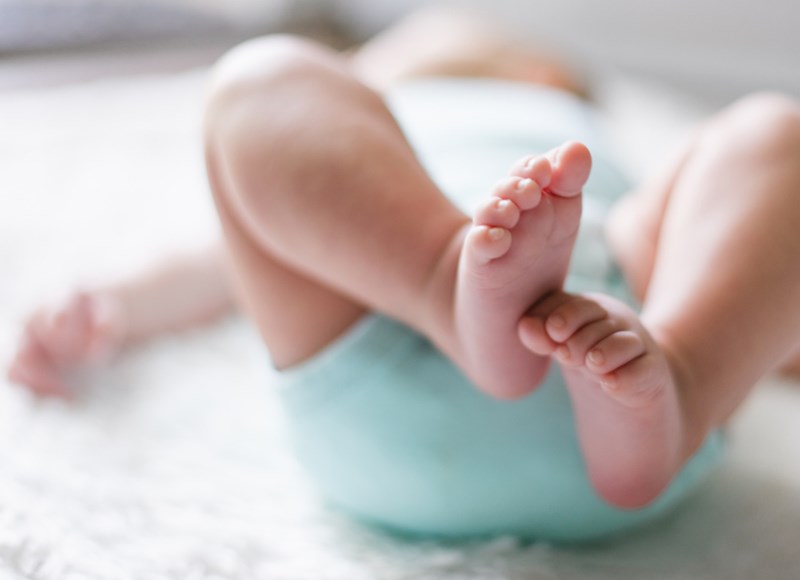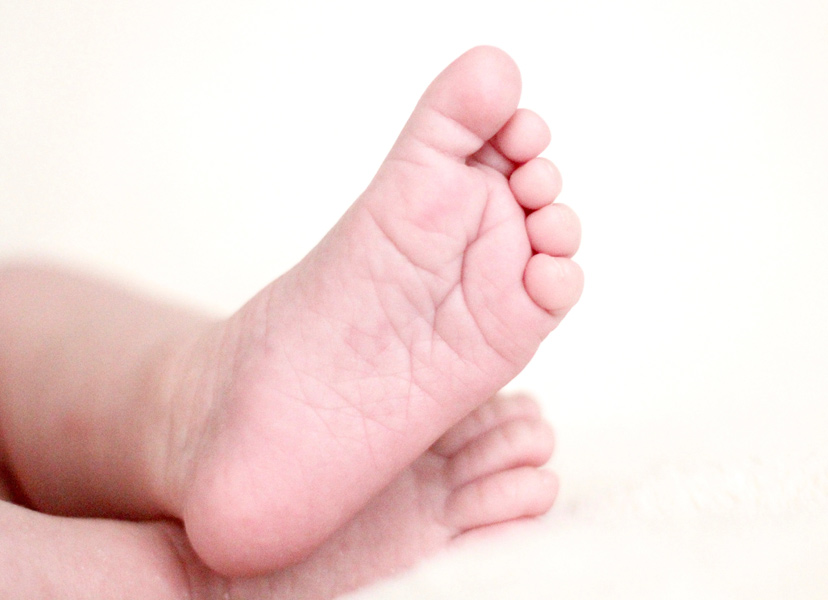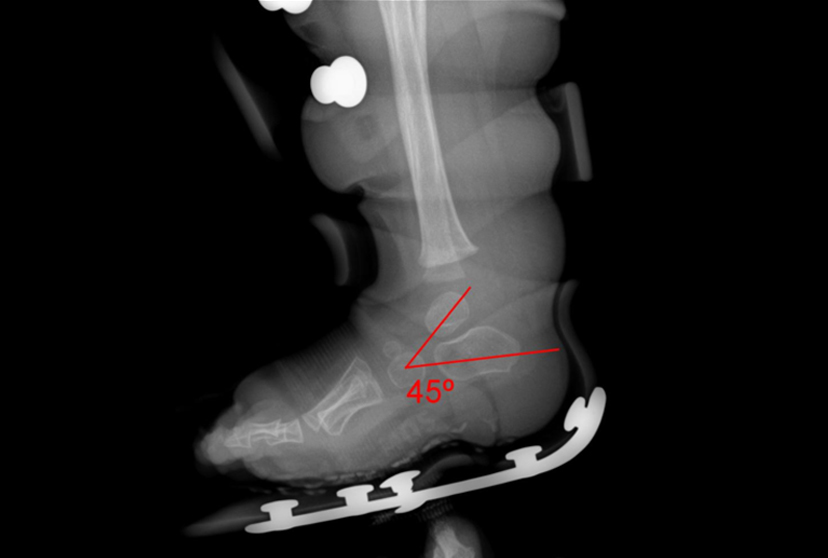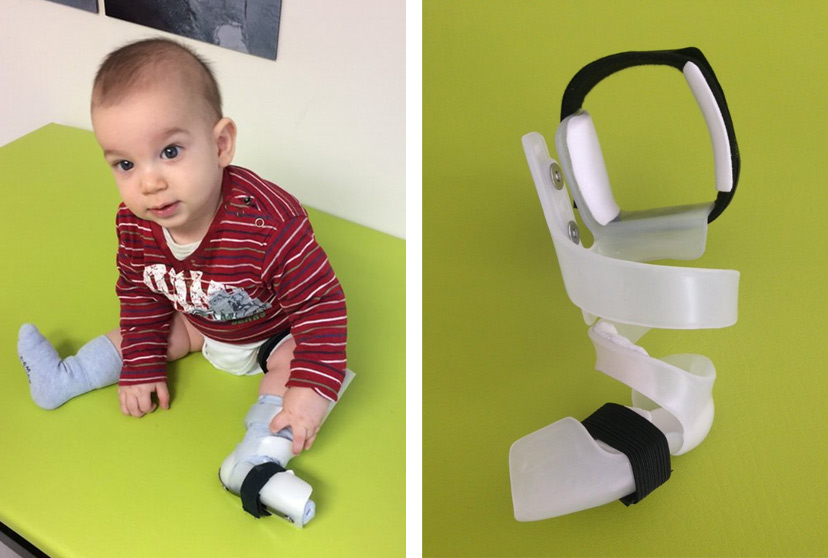
02 June 2021
June 3rd 2021 is Ponseti International Association’s World Clubfoot day – marking the birthdate of Dr Ignacio Ponseti, who originally developed the Ponseti method for treating clubfoot.
It’s also an important opportunity to raise awareness of clubfoot, and how the condition can be treated. NHS statistics say that around one in every 1,000 babies in the UK is born with clubfoot. If left untreated, clubfoot can cause pain and difficulty walking in later life. So, naturally, parents concerned about signs of clubfoot in their baby will be keen to know what the treatment options are.
It’s important to seek treatment early, while the baby’s bones are still malleable. There are strict protocols around the Ponseti Method – a worldwide treatment that is endorsed by, amongst others, Great Ormond Street Hospital.
Our Cunningham brace treatment is not an alternative to the Ponseti Method. Rather, it is a follow-up programme of dynamic orthotic bracing based on the method developed by American Prosthetist and Orthotist, Jerald Cunningham. We are the only UK orthotic clinic to offer this treatment, which offers an alternative to the traditional “boots and bar” method. Whilst effective, boots and bar can be a challenging treatment due to their rigidity and maintaining compliance throughout treatment.
Clubfoot is the common name for the condition congenital talipes equinovarus (CTEV). Congenital simply means a condition that is present from birth. Talipes equinovarus describes a combination of deformities that typically develop in the second trimester of pregnancy. The result is clubfoot, a condition that causes the foot (or feet) to present as if they are rotating at the ankle. The foot points down and inwards and the sole of the foot faces backwards. If left untreated, clubfoot in older children and adults often gives the impression that they are walking on the sides of their feet or even their ankles.

So, what’s the difference between boots and bar and the Cunningham brace? Well, boots and bar is a “rigid” treatment that holds both feet in place and secures them with a bar between the feet. Normally, after Ponseti treatment, boots and bar are fitted and worn consistently for the first three months, then worn during naps and nighttime until the age of around five or six years.
Boots and bar, although a well-established treatment for clubfoot, can be quite an undertaking for both the child and the parents! Its efficacy depends on achieving a very tight “hold” on both the child’s feet, which is counterintuitive to any child’s instinct to constantly move. It can cause discomfort, rubbing, and difficulty for the child when trying to sleep.
The Cunningham brace, by contrast, is a dynamic spring system that works by putting the foot in an overcorrected position. The child can move out of that position if they want to, once they're strong enough. But, because the brace is dynamic, it remains securely fitted even when the child is actively moving around. This also helps their muscular system to develop. The calf muscle, in particular, can often be smaller on the clubfoot side – or, if the clubfoot is bilateral, on both sides. Anecdotally, LOC orthotists have found that the child’s calf muscles are often more symmetrical after Cunningham brace treatment than they would expect them to be using boots and bar.
What’s more, the Cunningham brace can be adapted to each child’s individual presentation of clubfoot. If, for example, we see a case where a child’s toe is overlapping another toe, a big toe is dropping and it shouldn't be, or a heel cord is very tight, we can make adaptations to the brace to correct these issues.

Because the Cunningham brace is dynamic and therefore more comfortable, children find it easier to wear and parents find it easier to keep their child in the brace. It’s perfectly feasible for a child with clubfoot to wear a Cunningham brace for 23 hours a day in the first year. Because children in the earliest stages of life have much softer tissue and bones, that first year is a crucial window to get the best results from clubfoot treatment. So, the capacity of the Cunningham brace to deliver gentle, consistent adjustment in that first year can make a dramatic difference to results. Our ideal aim with clubfoot patients is to hold them in the Cunningham brace for 23 hours a day during year one. After that, we gradually reduce bracing to naps and night-time. When the child is in a standing position, the foot remains in a corrective position and then continues to be held in a corrective position as the brace goes back on for sleeping. This is a significant advantage, as it maximises correction time day to day, and therefore overall treatment time can often be reduced from five or six years (a typical time period for boots and bar) down to two or three years with the Cunningham brace.
It’s important to understand that the Cunningham brace is a follow-up treatment to the Ponseti method, not an alternative in its own right. Over a period of five to eight weeks, a Ponseti programme of manipulation and casting is continuously applied to the affected foot or feet, usually by a physiotherapist. That is followed by a small surgical procedure to lengthen the Achilles tendon (which is typically too tight) before boots and bar are usually fitted.
Some parents approach LOC to enquire about treatment even before their baby is born. Others come to us later, if their child is struggling to tolerate boots and bar and they want to find a gentler alternative. Once their brace is fitted, a child usually wears their first brace for five or six months, before moving to a new brace for a year, and then the third brace for another year.
It is possible to effectively treat clubfoot in adults as well. Adults may not have been offered the Ponseti Method, since it was only introduced to the UK in the late 1990s. Nonetheless, there is a lot that insoles, custom made footwear and ankle foot orthotics (AFOS) can do to help alleviate the symptoms and appearance of clubfoot.
If you are concerned about clubfoot, either in your unborn baby or your infant or as an adult, our orthotists are able to help and advise you. Treatment for babies is offered in our Kingston headquarters’ clinic while treatment for adults is available at all our satellite clinics. Just contact LOC using our online form, or call us on 020 8974 9989 to arrange an initial consultation.

Club foot, or clubfoot, is the general name given for a medical condition called congenital talipes equinovarus (CTEV). Congenital means that you’re born with the condition, which can occur in one or both feet. It is quite common, occurring in around one in every 1,000 babies born in the UK.
The Ponseti method involves manipulation and repeated weekly casting for about five to eight weeks. After that, a small procedure called a tenotomy is carried out under local anaesthetic to lengthen the tight heel cord – known as the Achilles tendon – in the back of your ankle. The treatment follows very strict, well-understood protocols and is the gold standard in corrective treatment for club foot. Indeed, the procedure is used and endorsed by Great Ormond Street.
The Cunningham Brace was designed by Jerald Cunningham, who runs his own clinic in the US. It works using a firm strap around the thigh and a spring that holds the brace up against the bottom of the foot. This means that the brace is always gently stretching your baby’s foot into the correct position, in a similar way that a therapist applies manipulation.
Jerald developed the brace at the request of an orthopaedic surgeon and colleague who saw how distressing the boots and bar process was for many children and parents. Jerald has worked on the design for more than 10 years, tweaking as he goes, based on x-ray evidence after every patient fitting.
No problem. Often parents come to us after they’ve tried persevering with the boots and bar treatment for a few months. It may change our treatment plan a little and your child might need treatment for a bit longer, but the process will essentially be the same.
At the moment we can fit the brace at our clinics in Kingston-upon-Thames and Bristol; in addition, we can do follow up appointments at our Manchester clinic. There is a certain amount we can do virtually, but your first fitting would need to be done in person.
We have the following facilities and amenities at our Kingston Upon Thames location:
We also have the Gait Laboratory for orthotics patients and Onsite Manufacturing for speedy turnarounds and adjustments whilst you wait.